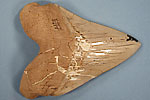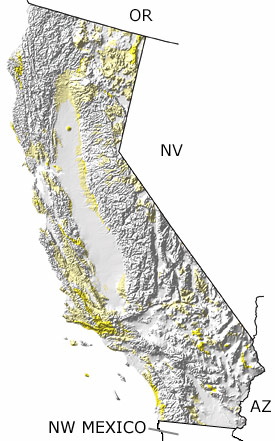|
|
|
 |
Choose a time period: |
 |
|
|
 |
 |
 |
 |
|
Tertiary Fossils


 |
(7 slides) | 
|
|
|
 |
 |
|
 |
|
Paleontology and geologyBecause much of western California was underwater during the Tertiary, marine deposits occur throughout the state. Marine sandstones and shales were alternately deposited and then eroded as sea levels changed. These marine rocks contain a diverse fauna of corals, bivalves, gastropods, scaphopods (tusk shells), echinoderms, and foraminifera (single-celled protists with shells). Although deposits from river channels, floodplains, and deltas can be found in northern counties, terrestrial sediments are more common in the south. The floras of these deposits indicate that the climate became less tropical and more temperate throughout most of the Tertiary. Increased tectonic activity in the Late Tertiary uplifted the Coast and Transverse Ranges, eliminated the inland sea that had filled the Central Valley, and generated widespread volcanism. California’s grasslands were filled with herbivores and carnivores. |
|
|
Links to more on the Tertiary in California |
|
Organizations | Education and Exhibits | Research and Collections | Resources
Organizations
Museums (showing 2 of 2 listings)
The Cooper Channel: From the Dr. John D. Cooper Center Archaeological and Paleontological Center, comes the Cooper Channel. A channel dedicated to producing educational shows for all ages that focus on Orange County paleontology and archaeology.
San Bernardino County Museum: The San Bernardino County Museum in Redlands, California is a Federally-recognized, accredited repository for thousands of invertebrate and vertebrate fossils from throughout southern California, Nevada, and the southwestern United States.
 Top of List Top of List
Government Agencies (showing 1 of 1 listings)
Dr. John D. Cooper Archaeological and Paleontological Center: The Dr. John D. Cooper Archaeological and Paleontological Center is dedicated to preserving the natural and cultural history of Orange County, California. The Cooper Center, a partnership between O.C. Parks and California State University Fullerton, is committed to the preservation, curation, and management of the fossils and artifacts collected within the County.
 Top of List Top of List
Education and Exhibits
Virtual Exhibits (showing 1 of 1 listings)
Geology and Paleontology of Red Rock Canyon: See vertebrate fossils collected in our popular weekend field trips by the Natural History Museum of Los Angeles County 
 Top of List Top of List
Research and Collections
Ongoing Research Projects (showing 1 of 1 listings)
Research at the Raymond M. Alf Museum of Paleontology: A description of the holdings and current research underway at the museum.
 Top of List Top of List
Resources
Courses and Lectures (showing 1 of 1 listings)
Paleogeography of the Southwestern U.S.: The paleogeography of the southwestern U.S. from 1.8 billion years ago to 10 million years ago. Text and images by Dr. Ron Blakey from Northern Arizona University.
 Top of List Top of List
Field Guides (showing 3 of 5 listings)
Fossils At Red Rock Canyon State Park, California: This site is devoted to the paleontology, geology, and natural history of Red Rock Canyon State Park, California; many images of fossils, scenic images of the park, plus images of wildflowers.
The Sharktooth Hill Bone Bed, Southern California: Take a virtual field trip to the classic Sharktooth Hill fossil bone bed northeast of Bakersfield, California; includes text, images of fossils, on-site images and paleontology links.
Fossil Plants Of The Ione Basin, California: The fossil plants of the Middle Eocene Ione Formation, Amador County, California; many images of fossil leaves, plus on-site images of field trips to the fossil leaf localities.
 More Field Guides More Field Guides
 Top of List Top of List
General Reference (showing 2 of 2 listings)
Fossils From The Kettleman Hills, California: The 4.5 to 2.0 million-year-old Pliocene-age fossils that occur in the Kettleman Hills, roughly 80 miles northwest of Bakersfield, California.
Fossils In Death Valley National Park: The paleontology, geology and natural wonders of Death Valley National Park (and more); many images of fossils; field trips; paleontology links, plus links to Death Valley.
 Top of List Top of List
|
|





